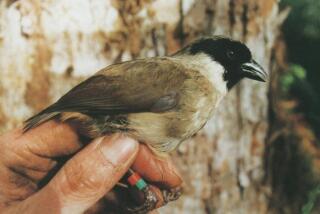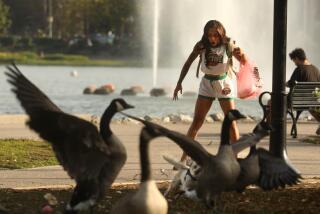Aleutian Goose Makes Its Way off Endangered Species List
- Share via
ANCHORAGE, Alaska — For more than 200 years, hungry foxes in the Aleutian Islands preyed upon the Aleutian Canada goose, driving the birds to near-extinction.
There were so few that scientists believed the geese that nest in the chain of southwest Alaska islands were extinct.
Then, in 1962 a remnant population of a few hundred birds was found on a remote island in the western Aleutians, and the fight to save the Aleutian Canada goose was on.
The recovery of the Aleutian Canada goose is a rare success story, U.S. Fish and Wildlife Service officials said Thursday as they celebrated the bird’s upcoming removal from the Endangered Species List. The geese will come off the list in the next few weeks, said LaVerne Smith, associate regional director for the U.S. Fish and Wildlife Service in Alaska.
The small goose with a distinctive white band around its neck has joined just a few other species, including the gray whale and the peregrine falcon, to make the long trek back and be delisted.
The road to recovery was not easy, and not just for the geese, said Brian Anderson, a Fish and Wildlife biologist.
Scientists involved in the recovery effort spent weeks hunkered down in tents that shredded in gale-force winds that whipped the Aleutian Islands. When the weather permitted, they carried geese in backpacks as they ferried them from one island to another, sometimes in wooden dories and later in more seaworthy vessels.
“I don’t think there’s any other recovery story that rivals this one,” Smith said.
Recovery efforts began in 1963 with the capture of some goslings to begin a captive breeding population. In 1967, the Aleutian Canada goose was declared an endangered species, the year after the 1966 Endangered Species Protection Act (the law that preceded the Endangered Species Act of 1973) became law.
In the 1970s, the captive-raised birds were relocated to islands free of foxes. An eradication program was begun to eliminate arctic and red foxes brought to the islands by Russian fur traders in the 1700s. Migratory habitat was protected in Oregon. Hunting was banned and land acquired to protect wintering grounds in California.
When the formal recovery program got under way in 1975, there were an estimated 790 birds. By 1984, the geese had begun successfully breeding on one of the fox-free islands. By 1990, when populations had risen to an estimated 6,300 birds, the geese were reclassified from endangered to threatened. New populations were established on Agattu, Alaid and Nizki islands in the Aleutians.
“The geese started to take off on their own,” Anderson said.
By July 1999, with numbers over 30,000, the U.S. Fish and Wildlife Service declared the species recovered. There are now an estimated 37,000 Aleutian Canada geese and Russian scientists are working on their own recovery program.
More to Read
Sign up for Essential California
The most important California stories and recommendations in your inbox every morning.
You may occasionally receive promotional content from the Los Angeles Times.













